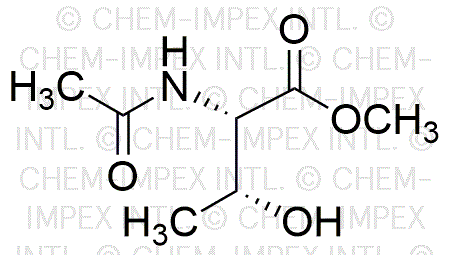Acetyl-L-threonine methyl ester is widely utilized in research focused on:
- Pharmaceutical Development: This compound serves as a building block in the synthesis of various pharmaceuticals, particularly in the development of amino acid derivatives that can enhance drug efficacy.
- Nutrition Supplements: It is used in formulating dietary supplements aimed at improving muscle recovery and overall health, capitalizing on its role in protein synthesis.
- Biochemical Research: Researchers utilize it to study metabolic pathways and the effects of amino acids on cellular functions, providing insights into nutrition and health.
- Cosmetic Formulations: The compound is incorporated into skin care products for its moisturizing properties, helping to improve skin hydration and texture.
- Food Industry: It is explored as a potential flavor enhancer or additive, contributing to the development of healthier food options without compromising taste.
General Information
Properties
Safety and Regulations
Applications
Acetyl-L-threonine methyl ester is widely utilized in research focused on:
- Pharmaceutical Development: This compound serves as a building block in the synthesis of various pharmaceuticals, particularly in the development of amino acid derivatives that can enhance drug efficacy.
- Nutrition Supplements: It is used in formulating dietary supplements aimed at improving muscle recovery and overall health, capitalizing on its role in protein synthesis.
- Biochemical Research: Researchers utilize it to study metabolic pathways and the effects of amino acids on cellular functions, providing insights into nutrition and health.
- Cosmetic Formulations: The compound is incorporated into skin care products for its moisturizing properties, helping to improve skin hydration and texture.
- Food Industry: It is explored as a potential flavor enhancer or additive, contributing to the development of healthier food options without compromising taste.
Documents
Safety Data Sheets (SDS)
The SDS provides comprehensive safety information on handling, storage, and disposal of the product.
Product Specification (PS)
The PS provides a comprehensive breakdown of the product’s properties, including chemical composition, physical state, purity, and storage requirements. It also details acceptable quality ranges and the product's intended applications.
Certificates of Analysis (COA)
Search for Certificates of Analysis (COA) by entering the products Lot Number. Lot and Batch Numbers can be found on a product’s label following the words ‘Lot’ or ‘Batch’.
*Catalog Number
*Lot Number
Certificates Of Origin (COO)
This COO confirms the country where the product was manufactured, and also details the materials and components used in it and whether it is derived from natural, synthetic, or other specific sources. This certificate may be required for customs, trade, and regulatory compliance.
*Catalog Number
*Lot Number
Safety Data Sheets (SDS)
The SDS provides comprehensive safety information on handling, storage, and disposal of the product.
DownloadProduct Specification (PS)
The PS provides a comprehensive breakdown of the product’s properties, including chemical composition, physical state, purity, and storage requirements. It also details acceptable quality ranges and the product's intended applications.
DownloadCertificates of Analysis (COA)
Search for Certificates of Analysis (COA) by entering the products Lot Number. Lot and Batch Numbers can be found on a product’s label following the words ‘Lot’ or ‘Batch’.
*Catalog Number
*Lot Number
Certificates Of Origin (COO)
This COO confirms the country where the product was manufactured, and also details the materials and components used in it and whether it is derived from natural, synthetic, or other specific sources. This certificate may be required for customs, trade, and regulatory compliance.


